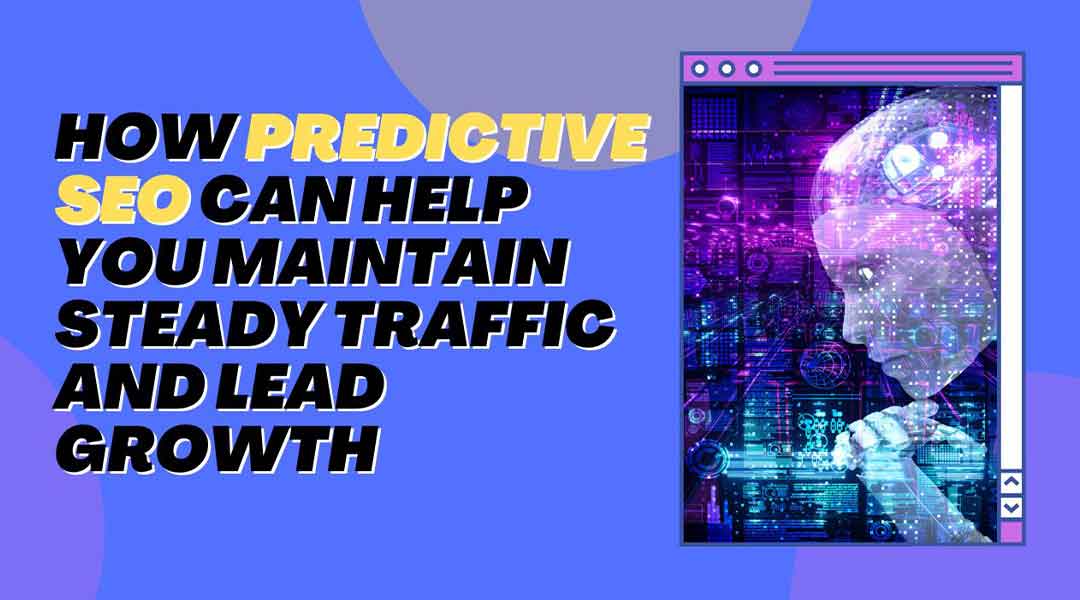Organic traffic can be a fickle thing. It feels like every time you try to grow it, you end up losing more than you gain.
It is like trying to fill up a bucket with water, but every time you come back to check on it, half the water has already leaked out. Your website is the bucket, and your traffic is the water.
This can be incredibly frustrating if you feel like you are doing everything right. You have a great content calendar planned out. You publish quality content regularly. Your blog posts even rank well on search engine results pages (SERP).
But then, suddenly, your traffic starts to decline. No matter how much content you publish, you can’t seem to get the numbers up. What if there was a way to prevent traffic loss and keep a steady flow of leads coming in? Predictive SEO can help you do just that.
Predictive SEO uses data and analytics to find the beginning stages and trends related to traffic loss. By identifying these early signs, you can take steps to prevent a decline in traffic.
What is Predictive SEO?
Predictive SEO is the process of using data to make predictions about future traffic patterns and trends. This data can come from a variety of sources, including:
- Google Analytics
- Search Console
- SERP data
- Clickstream data
This data is then analyzed to identify patterns and trends. Once these patterns and trends are identified, predictions can be made about future traffic.
For instance, predictive SEO can identify the early stages of a traffic decline. By identifying these early stages, you can take steps to prevent further decline.
It can also be used to identify traffic trends. This information can be used to plan future content. For instance, if you know that a specific type of content is predicted to perform well in the future, you can plan to write and refresh content in advance.
Predictive SEO can help you in some ways, including:
- Preventing traffic loss
- Increasing traffic
- Improving SERP rankings
- Generating leads
In short, predictive SEO can help you stand out from your competitors and maintain a steady flow of traffic and leads.
How to Find What to Improve?
To find the right predictive SEO strategy for your business, you’ll need to start by identifying your goals. What are you hoping to achieve with predictive SEO? Once you know your goals, you can start to collect and analyze data.
There are several ways to collect data. One way is to use predictive search. The predictive search uses data from past searches to predict what people are likely to search for in the future. This data can be used to identify trends and plan content.
Since the scope of predictive SEO is huge, it can be helpful to focus on a specific area. We’ll focus on one of the most common goals: improving content to increase traffic.
Conduct a Condensed Content Audit
The first step is to conduct a condensed content audit. The goal of the audit is to identify which pieces of content are performing well and which ones need to be updated.
Condensed content audits can help you pinpoint the areas that need improvement. These insights can be used to update your content strategy. It will provide you with a list of content that needs to be updated and a plan for how to update it.
Some factors you may want to consider when conducting your audit:
1. Is the content outdated?
2. Does the title need to be updated?
3. Are the images current?
4. Is the formatting up-to-date?
5. Are the links working?
6. Is the call-to-action (CTA) effective?
7. Is the content engaging?
8. Does the content align with your brand voice?
9. Is the content keyword-rich?
10. Is the metadata up-to-date?
These are just a few factors you may want to consider when conducting your audit. Once you’ve identified the areas that need improvement, you can begin to update your content strategy.
You can use SEO tools like SEMrush’s Content Audit tool to help you analyze your content. This tool can help you identify which pieces of content are performing well and which ones need to be updated.
Grade Your Content Assets
After you conduct your audit, it’s time to grade your content assets. This will help you identify which pieces of content are high-quality and which ones need to be improved.
To grade your content, you’ll want to consider some factors, including:
1. Does the content entertain and educate?
2. Does the content convert?
3. Does the content connect?
If your content doesn’t hit all three objectives, it may be time to update it. High-quality content that accomplishes these three goals will improve your SEO efforts.
You can use a tool like Moz’s Page Optimization tool to help you grade your content. This tool will help you identify which areas of your content need to be improved.
Review Content That Performed Well In the Past
One predictive SEO strategy is to review content that performed well in the past. This can help you identify which topics are still relevant and which ones need to be updated.
To find content that performed well in the past, you can use a tool like Google Analytics. This tool can help you identify which pieces of content are getting the most traffic.
The important thing to remember is that just because a piece of content performed well in the past doesn’t mean it will perform well in the future. You’ll still need to update the content to ensure it’s relevant and engaging.
Conduct Predictive Analysis to Find New Opportunities
Predictive analysis can help you identify new opportunities for content. This type of analysis looks at data to predict future trends.
It can help you unravel the why behind customer behavior. This information can be used to improve your content strategy.
Predictive analysis helps you scan through millions of sites to understand what people are talking about. This can help you plan your content around these topics.
Some predictive analysis tools you may want to consider include:
1. Google Trends
2. BuzzSumo
3. SEMrush
4. Google AdWords Keyword Planner
You can also leverage CORE AI technology to predict your keyword rankings. This type of technology can help you improve your content strategy and get ahead of your competition.
By using predictive analysis, you can stay ahead of the curve and create relevant content for your audience.
Analyze Your Website Traffic
The best way to analyze your traffic is to divide it into two categories: Restoring and Protecting traffic.
Restoring traffic is the traffic that has already dropped from organic search. To restore traffic, you’ll need to take steps to fix the issues associated with the drop in traffic. You’ll also need to analyze each page to see what’s causing the drop in traffic.
Protecting traffic is the traffic you haven’t lost yet. This is where predictive SEO comes into play. It gives you the ability to protect your page’s traffic before it gets lost. It means taking all necessary steps at an early stage before anything bad happens.
It is common to react to a traffic drop when it has already happened. But by the time you start your restoration process, the damage is already done. You may have lost subscribers, customers, or even sales.
With predictive SEO, you can take steps to protect your traffic and prevent these losses.
Predictive SEO is a proactive approach that uses data to predict future trends. By analyzing past traffic patterns, you can take steps to protect your traffic before it drops.
How to Predict Falling Traffic
You don’t need to be a wizard to use predictive SEO. Predictive SEO is relatively easy to do. All you need is data. And from there, you can use predictive analysis to find new opportunities and take steps to protect your traffic.
You need to gather SEO data to help you see what blog posts and habits could cause your traffic to go away if you continue doing something that doesn’t engage your audience.
The best way to predict falling traffic is to use AI technology in conjunction with predictive analytics. However, suppose you don’t have access to these tools. In that case, you can also do it manually by considering SEO factors like keyword rankings, the relationship between keywords, search volume, organic traffic, and SERP position.
When you measure and analyze the relationship between these components, you can get an idea of which blog posts are at risk of dropping in traffic. You can use SEO tools to get an inside look at this information. These tools can provide you with historical data that shows you how a ranking falls over time.
From there, you just need to check your ranking keywords, assess their position, and then draw a trendline to detect ranking drops. When you see a ranking drop happening, you can then take steps to restore your traffic before it’s too late.
Top 3 SEO Tools for Predicting Traffic Trends
The predictive SEO concept is relatively new. However, there are already a few tools that you can use to help you with your predictive SEO efforts.
Here are three of the top SEO tools that you should consider using:
1. Google Analytics And Google Search Console
Google Analytics and Google Search Console are two of the best SEO tools you can use for predictive SEO. Google Analytics provides you with insights into your website traffic. It also allows you to track your progress over time. It also helps you check whether your content marketing strategies are working or not.
Google Search Console, on the other hand, gives you insights into your website’s search performance. It also allows you to troubleshoot and monitor your website’s appearance on the search engine results page. In addition, it presents you with information about your ranking increases and decreases.
Both of these Google tools are essential for predictive SEO. By using them together, you can be prepared to protect your traffic by identifying trends and taking steps to prevent traffic drops.
2. Exploding Topics
Exploding Topics is a keyword research tool that analyzes millions of conversations, searches, and mentions across the internet. It then sends you a list of trending topics and keywords every week.
You can use this information to develop relevant content for your target audience. This will help you stay ahead of the competition by being the first one to address a topic that your target audience is interested in.
3. Ahrefs
Ahref provides a comprehensive SEO software package that includes predictive tools for keyword research, rank tracking, competitor analysis, site audits, link building, and more.
Their SEO tools help analyze your customer’s search intent and allow you to learn from top-performing content in your industry. This will help ensure that your content is always relevant and engaging to your target audience.
Predictive SEO is a new concept that is quickly gaining popularity. It can help you take steps to protect your traffic and ensure that your content is always relevant to your target audience. By using the predictive SEO tools mentioned above, you can be prepared to protect your traffic and prevent a drop in ranking.










One comment
Wendy Haggerty
October 27, 2022 at 12:34 pm
You have mentioned a few of my favorite websites and tools here and they helped me to maintain and monitor traffic. By the way, you did amazing in writing this blog!
Comments are closed.